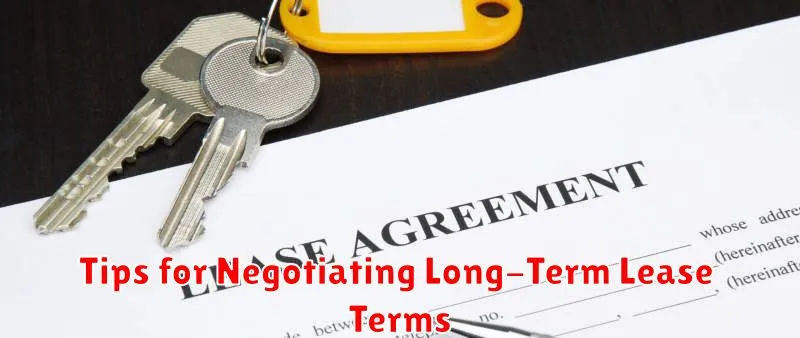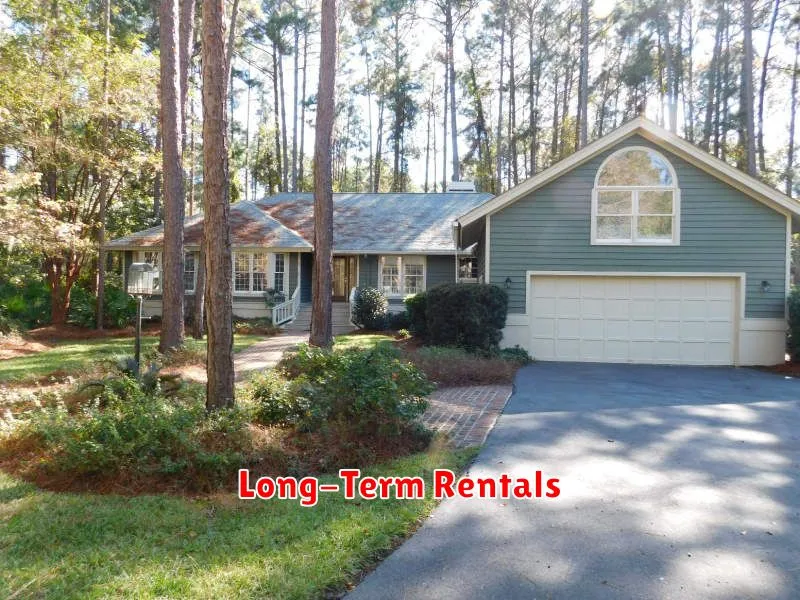Finding the perfect long-term rental can feel like a monumental task, but it doesn’t have to be! This guide will walk you through the process of locating long-term rentals that truly align with your lifestyle. Whether you’re searching for a cozy apartment in the city, a spacious house in the suburbs, or a unique rental property in a rural setting, we’ll cover essential tips and tricks to streamline your search and help you find the ideal long-term lease that meets all your needs and exceeds your expectations. Let’s embark on this journey to discover your dream long-term rental home!
Introduction: Choosing the Right Long-Term Rental
Finding the perfect long-term rental can feel overwhelming. With so many options available, it’s crucial to approach your search strategically. This process begins with understanding your lifestyle and prioritizing your needs. What features are truly essential, and which are merely nice-to-haves?
Consider factors like budget, location, and desired amenities. A realistic budget is paramount; overspending can strain your finances. Think about your daily commute, proximity to work or school, and access to essential services when evaluating location. Do you need a pet-friendly space, parking, or a specific number of bedrooms and bathrooms? Listing your priorities will streamline your search significantly.
This guide will walk you through the process of identifying your ideal rental, from defining your needs to effectively navigating the rental market. By clearly understanding your lifestyle preferences and setting realistic expectations, you can confidently find a long-term rental that not only meets your needs but also enhances your overall quality of life.
What to Look for in a Long-Term Rental Property

Finding the perfect long-term rental involves careful consideration of several key factors. Location is paramount. Think about proximity to work, schools, transportation, and amenities you value. Consider the neighborhood’s safety and overall vibe; a walk around at different times of day can be insightful.
The property itself should meet your size and layout needs. Assess the number of bedrooms and bathrooms, storage space, and overall living area. Appliances and features are crucial; ensure everything is in good working order or that repairs are addressed promptly by the landlord. Look for energy-efficient appliances to save money on your utility bills.
Lease terms are another significant consideration. Carefully review the lease agreement, understanding the length of the lease, rental amount, and responsibilities of both landlord and tenant. Clarify pet policies, parking arrangements, and any restrictions on renovations or alterations. It’s crucial to understand the landlord’s communication style and responsiveness to ensure a smooth tenancy.
Finally, don’t underestimate the importance of your gut feeling. A property may check all the boxes on paper, but if you feel uncomfortable or unsure, it’s worth considering other options. Finding a long-term rental is a significant decision, so trust your instincts.
Evaluating Locations Based on Your Needs
Finding the right long-term rental involves more than just finding a nice apartment; it’s about finding a location that truly fits your lifestyle. Consider your daily commute. Is a longer commute acceptable for the right price and amenities, or is proximity to work a top priority? Think about your social needs too. Do you want to be near friends, family, or vibrant city life, or would you prefer a quieter, more suburban setting?
Evaluate the amenities offered by different locations. Are there nearby parks, grocery stores, restaurants, and other essential services? Access to public transportation is also crucial for some. If you don’t own a car, ensure your chosen location is well-served by buses, trains, or other public transit options.
Your budget heavily influences location choices. Rent prices fluctuate dramatically across different areas. Research average rental costs in your preferred areas to ensure your chosen location aligns with your financial plan. Also consider the overall cost of living, including utilities, groceries, and transportation. Sometimes a seemingly cheaper rent can be offset by higher costs elsewhere.
Finally, consider your personal preferences. Do you prioritize safety, walkability, access to nature, or a specific school district? Weighing these factors carefully will help you narrow your search and find a location that perfectly complements your long-term rental needs and enhances your overall quality of life.
How to Budget for Long-Term Housing
Securing long-term housing requires careful budgeting. Start by determining your maximum affordable rent. A general rule of thumb is to spend no more than 30% of your gross monthly income on rent, but this can vary based on your financial situation and other expenses.
Next, create a detailed budget that includes all your monthly expenses, such as utilities (electricity, water, gas, internet), groceries, transportation, insurance, debt payments, and entertainment. Subtracting these expenses from your monthly income will reveal how much you have left for rent.
Consider hidden costs associated with renting. These might include security deposits, pet fees (if applicable), application fees, and potential moving expenses. Factor these into your budget to avoid unexpected financial strain.
Explore different rental options within your price range. Consider factors like location, amenities, and property size to find the best fit for your lifestyle and budget. Don’t be afraid to negotiate rent or explore shared housing options to reduce costs if necessary.
Finally, regularly review your budget and make adjustments as needed. Life circumstances change, and your budget should reflect these changes to maintain financial stability and ensure your long-term housing remains affordable.
The Role of Amenities in Rental Selection
Choosing a long-term rental involves more than just location; amenities play a crucial role in determining your overall comfort and satisfaction. The availability of specific features can significantly impact your lifestyle and daily routines.
Consider what truly matters to you. Do you need in-unit laundry to save time and trips to a laundromat? Is a parking space a necessity, or would you be comfortable relying on street parking? A pet-friendly policy might be essential if you have furry companions. These seemingly small details can drastically alter your living experience.
Beyond the basics, think about features that enhance your lifestyle. A gym in the building can save you a gym membership. A swimming pool offers a refreshing escape during hot months. Outdoor space, such as a balcony or patio, can provide a valuable area for relaxation and entertainment. Carefully evaluating these amenities ensures you select a rental property that truly fits your lifestyle and preferences.
Remember to weigh the cost of amenities against their value to you. While certain features might be appealing, they often come at a higher price. Prioritize the amenities that will significantly improve your daily life and make your rental experience more enjoyable. This careful consideration will help you make an informed decision and find the perfect long-term rental.
Comparing Apartments vs. Houses for Long-Term Leases
Choosing between an apartment and a house for a long-term lease is a significant decision impacting your lifestyle and budget. Apartments generally offer lower upfront costs, including smaller security deposits and potentially lower monthly rent. They often include amenities like pools and fitness centers, and require less maintenance; you usually only need to worry about your unit. However, apartment living often means less privacy and limited space, potentially leading to noise issues from neighbors.
Houses, on the other hand, provide significantly more space and privacy. You’ll usually have a yard and potentially a garage, offering more storage and outdoor living options. However, houses typically involve higher monthly rent and significantly larger security deposits. The responsibility for maintenance and repairs also falls primarily on you, which can be costly and time-consuming. Consider factors like yard work, snow removal, and appliance repairs when evaluating the overall cost.
Ultimately, the best choice depends on your individual needs and priorities. If you prioritize affordability, convenience, and built-in amenities, an apartment might be a better fit. If you value privacy, space, and a greater sense of control over your living environment, a house might be preferable. Carefully weigh the pros and cons of each option to make an informed decision that aligns with your long-term lifestyle goals and financial capabilities.
Tips for Negotiating Long-Term Lease Terms

Securing a long-term rental requires careful negotiation. Knowing your leverage and approaching the discussion strategically is key. Start by researching comparable rentals in the area to understand market value and potential concessions. This information gives you a solid foundation for your negotiations.
Don’t be afraid to counteroffer. Landlords often set initial terms higher, anticipating negotiation. A well-reasoned counteroffer, backed by your market research, shows you’re a serious tenant. Consider proposing a longer lease term in exchange for a lower monthly rent or other concessions.
Negotiate lease terms beyond rent. This is where you can truly personalize your lease. Consider negotiating details such as pet fees, parking, utilities included, or the possibility of lease renewal options. Clearly outline your requests in writing.
Communicate effectively and professionally. Maintain a respectful tone throughout the negotiation process. Clearly express your needs and be prepared to compromise. A strong working relationship with your landlord can lead to a smoother and more positive experience.
Get everything in writing. Once an agreement is reached, ensure all negotiated terms are clearly outlined in the lease agreement. Review the document carefully before signing to avoid any misunderstandings or disputes later on. Having a lawyer review the lease is a wise precaution, particularly for complex negotiations or significant lease terms.
Conclusion: Finding a Rental That Matches Your Lifestyle
Finding the perfect long-term rental is a journey, not a race. By carefully considering your budget, lifestyle needs, and location preferences, you can significantly increase your chances of finding a place that truly feels like home. Remember to be patient, persistent, and proactive in your search. Don’t settle for less than you deserve – the right rental property is out there, waiting for you.
Throughout this process, remember the importance of thorough research. Online resources and local real estate agents can be invaluable tools. Taking the time to visit potential properties and ask questions will ensure you make an informed decision. The investment in your time and effort will pay off in the long run, providing you with a comfortable and enjoyable living space.
Ultimately, the ideal rental is a reflection of your individual priorities and values. By prioritizing your needs and thoroughly vetting potential options, you can successfully secure a long-term rental that not only meets but exceeds your expectations, allowing you to thrive in your new environment. Happy house hunting!

